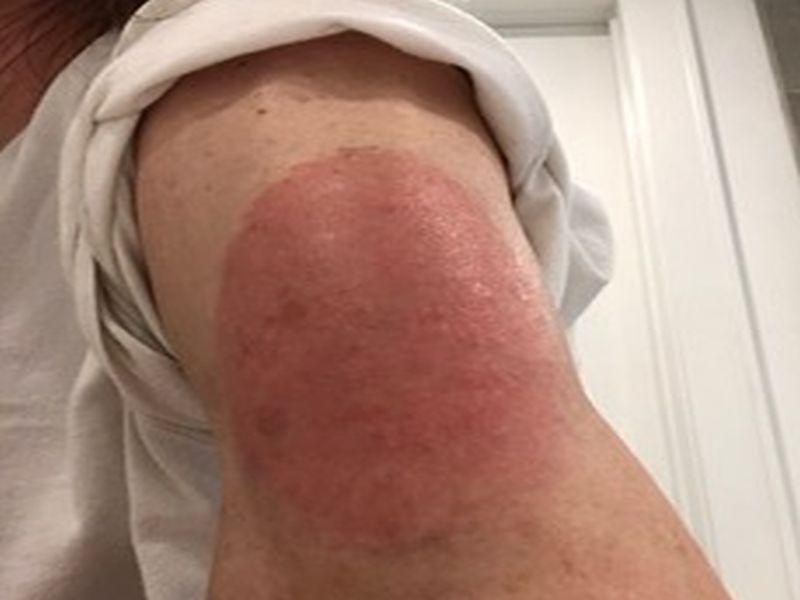THURSDAY, April 15, 2021 (HealthDay News) — Dermatologists liken skin to a window that can reveal what is going on inside the body, and a rash that sometimes follows a COVID-19 vaccine is one example.
When you get the shot, your immune system activates, preparing to recognize and fight off the virus in the future. This response and the inflammation that goes with it can occasionally result in a rash. But experts say as long as it happens more than four hours after the shot, there’s no need to worry.
Skin reactions like hives or swelling that appear within four hours, however, may be a sign of a rare but severe allergic reaction, according to the U.S. Centers for Disease Control and Prevention.
Dr. Esther Freeman is principal investigator in charge of a registry that tracks skin reactions to COVID-19 and its vaccine.
“One thing is important to note, the registry can’t tell us exactly what percentage of everyone getting a COVID vaccine will develop a skin reaction, because the registry is just the cases,” said Freeman, director of Global Health Dermatology at Massachusetts General Hospital in Boston.
“So, if someone gets a skin reaction, we hear about it, but we don’t hear about the people who don’t get a skin reaction,” she added.
Since the pandemic began, the American Academy of Dermatology and the International League of Dermatological Societies have collected thousands of reports of skin reactions to SARS-CoV-2 (the virus that causes COVID-19). In December, when the Pfizer and Moderna mRNA vaccines were authorized for emergency use in the United States, this registry also began including reports of vaccine-related skin reactions.
Between December 2020 and February 2021, it counted 414 cases of skin reactions after an mRNA vaccine. The various types of potential reactions were detailed in a report published online recently in the Journal of the American Academy of Dermatology. Freeman is corresponding author of the study.
The researchers found that a wide variety of rashes can follow the COVID-19 mRNA shots. The findings do not include reactions to the Johnson & Johnson vaccine, because it was not yet authorized for use when the study was done.
Some reactions develop soon after vaccination, while others arise up to 14 days after, the study authors noted.
“There’s quite a range in timing,” Freeman said.
While skin reactions related to the COVID-19 vaccines are rare, Freeman said it is difficult to determine exactly how rare. Most reactions went away without any medical intervention. Others were treated successfully with antihistamines, topical steroids or other remedies recommended by skin specialists.

Photo credit: Dr. Esther Freeman, MGH
assets.rebelmouse.io
Importantly, none of the patients who reported rashes went on to develop a severe allergic reaction, according to the study. Of those who got a rash after their first shot, less than half had a second-dose reaction.
“It’s pretty rare to get these in the first place, but if you happen to be among that rare group that gets a rash to the first vaccine — as long as it started more than four hours after your vaccine — we can provide a lot of reassuring data that you can go ahead and get your second vaccine,” Freeman said.
The CDC agrees, saying that people who get a delayed rash on their arm after the first shot should still get the second shot.
Large rashes near the vaccine injection site were the most commonly reported reactions in the study.
These are often nicknamed “COVID arm” or “Moderna arm,” as they seem to follow Moderna’s mRNA vaccine more often than Pfizer’s, for reasons that remain unclear, according to Freeman.
The registry counted 218 of these large local reactions, with 94% of them related to the Moderna shot. These rashes typically clear up within three to four days, according to the study.
Freeman said COVID arm can be itchy, red and swollen.
“It usually presents as a big red splotch on your arm, roughly in the area where you got vaccinated, but it can be a lot larger, like six to 12 inches across,” she noted.
Other commonly reported reactions included smaller irritations at the injection site, followed by hives and full-body rashes. Like COVID arm, these can be itchy and uncomfortable, but they typically last no more than a couple of days.
The study also revealed more unusual reactions, including nine reports of pernio/chilblains — also known as “COVID toes” — which can result in swelling, itchiness and color changes in the toes. It emerged early in the pandemic as a possible symptom of the virus that usually accompanies mild cases. It now appears to also be a rare side effect of the vaccines.
According to Freeman, COVID toes appear to indicate that the body is successfully mounting an immune response to the virus.
Some dermatologists also are hearing from patients who are experiencing these types of post-vaccine skin reactions.
Dr. Michele Green, a dermatologist at Mount Sinai Hospital in New York City, said some of her patients have reported reactions at the injection site, including swelling, redness and pain. All of those reactions went away within days.
“As far as dermatology, there have not been any serious adverse reactions noted post-COVID vaccine which needed intervention,” Green added.
According to the CDC, people with itchy rashes may consider taking antihistamines, while painful rashes can be relieved by over-the-counter pain medications, such as Tylenol or Advil.
If you develop a post-vaccine rash that persists or is particularly uncomfortable, Freeman suggested reaching out to a dermatologist, who can help ease discomfort and speed recovery.
More information
The U.S. Centers for Disease Control and Prevention has more about common side effects to the COVID-19 vaccine.
SOURCES: Esther Freeman, MD, PhD, board-certified dermatologist, director, Global Health Dermatology, Massachusetts General Hospital, Boston; Michele Green, MD, board-certified dermatologist, Mount Sinai Hospital, New York City; Journal of the American Academy of Dermatology, April 7, 2021, online
Copyright © 2025 HealthDay. All rights reserved.

